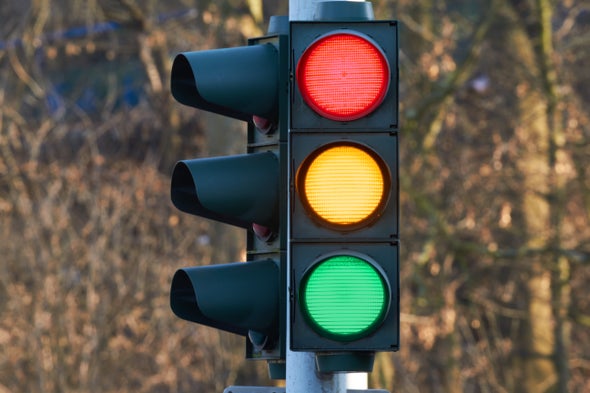What States Have Red Light Cameras

Red Light Cameras May Not Make Streets Safer
Fear of fines may fuel more sudden stops and rear-end accidents

The following essay is reprinted with permission from The Conversation, an online publication covering the latest research.
The automobile is a killer. In the U.S., 36,675 people died in traffic accidents in 2014. The twelvemonth before, 2.iii million people were injured in traffic accidents.
During the by decade, over 438 U.S. municipalities, including 36 of the 50 most populous cities, take employed electronic monitoring programs in society to reduce the number of accidents. Blood-red light camera programs specifically target drivers that run red lights.
In a study I co-authored with economist Paul J. Fisher, we examined all law-recorded traffic accidents for three large Texas cities over a 12-twelvemonth period – hundreds of thousands of accidents. We institute no evidence that reddish light cameras meliorate public safety. They don't reduce the total number of vehicle accidents, the total number of individuals injured in accidents or the total number of incapacitating injuries that involve ambulance ship to a hospital.
Carmine light cameras
In a reddish light photographic camera plan, a camera is installed in a location where information technology tin can take photos or video of vehicles as they pass through the intersection. City employees or private contractors then review the photos. If a vehicle is in the intersection when the light is scarlet, then a ticket is sent to the person who registered the vehicle.
These programs aim to reduce cross-street collisions. The thought is that drivers, fearing a college chance that they will be fined, will exist more likely to stop, lowering the number of angle, or "T-bone," accidents.
Testify clearly shows that camera programs are effective at decreasing the number of vehicles running reddish lights. In one written report in Virginia, red light cameras reduced the number of total drivers running red lights by 67 pct.
However, cameras tin take contradictory effects on traffic safety. Some drivers who would accept otherwise continued to proceed through the intersection when the light is yellowish or reddish will now attempt to stop. That ways that the number of accidents acquired by vehicles not stopping at a red light will likely decrease.
But the number of accidents from stopping at a blood-red light – such every bit rear-end accidents – is likely to increase. That's not an inconsequential side upshot. Some drivers volition attempt to stop, accepting a higher adventure of a non-angle accident like getting rear-ended, in order to avoid the expected fine.
The overall effect of a camera program on vehicle accidents and injuries depends on the cyberspace bear upon of these two effects. Overall commuter safety could increase or decrease.
Our study
In our report, we focused on Houston, a major U.Due south. metropolis that operated a large photographic camera programme at 66 intersections between 2006 and 2010.
One reason nosotros chose Houston is to take advantage of the natural experiment that occurred when metropolis residents passed a plebiscite in November 2010 to ban the cameras.
We accessed detailed accident information on every traffic blow in Texas from 2003 to 2014 through a public records information request. The data included the accident'southward precise geocoded location; the blazon of accident; whether the driver ran a blood-red light; and details on any injuries.
When the Houston cameras were removed, angle accidents increased past 26 pct. However, all other types of accidents decreased by 18 pct. Approximately one-third of all Houston intersection accidents are angle accidents. This suggests that the programme's drawbacks canceled out its benefits.
Our study showed no evidence that cameras reduce the total number of accidents. We approximate that total accidents are reduced past a statistically insignificant iii percentage afterwards the cameras are turned off.
Likewise, there's no evidence that the photographic camera plan reduced the number of traffic-related injuries or the likelihood of incurring an incapacitating injury.
The elevated number of traffic accidents at urban intersections is a serious public health event. But our study shows that Houston's camera program was ineffective in improving traffic safety. Electronic monitoring is not the solution.
This commodity was originally published on The Chat. Read the original article.
Source: https://www.scientificamerican.com/article/red-light-cameras-may-not-make-streets-safer/
Posted by: kuhlwilyingeld.blogspot.com


0 Response to "What States Have Red Light Cameras"
Post a Comment